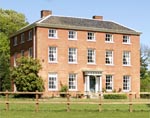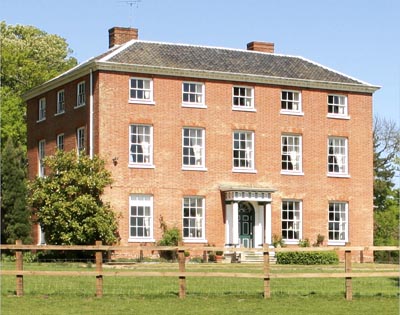Country houses for sale in East Anglia
East Anglia has some of the most appealing country houses for sale on the market


Described by selling agent Louis de Soissons of Savills as ‘the quint-essentially manageable Georgian house overlooking its own magnificent parkland in a wonderfully unspoilt part of Suffolk', Grade II-listed Brampton Hall (pictured) at Brampton, seven miles south of Beccles on the Norfolk/Suffolk border, hasn't been on the market for 40 years. Savills (01603 229229) quote a guide price of £2 million for the imposing former rectory, built in 1796 of red brick under a glazed black pantile roof for the Rev Naunton Thomas Orgill-Leman, whose family had long been associated with the area.
Set in 24 acres of formal gardens, park and woodland, six miles from the chic coastal resort of Southwold, Brampton Hall was bought by the current vendors in 1972, and substantially restored at that time. Since then, it has been continuously updated, refurbished and redecorated, without losing its Georgian character. Large, but not dauntingly so, the hall has 7,526sq ft of accommodation on three floors, including entrance and staircase halls, four main reception rooms, a kitchen/breakfast room, a conservatory, nine bedrooms, four bathrooms and a one-bedroom annexe. A range of outbuildings includes extensive garaging and stabling.
The same agents quote a guide price of £1.1m for the classic Tudor Knapton Old Hall at Knapton, 18 miles north of Norwich and two miles from the coast at Mundesley. Last sold in 1980, when it was bought by the family of the current vendors, Knapton Old Hall, listed Grade II, dates from about 1530, but was altered and extended in the 18th century, and again in the Arts-and-Crafts style in the early 1900s. Built in the trad-itional Norfolk style of flint and brick under a part-pintile, part-pantile roof, the house still retains much of its Tudor character, including crow-stepped gables, brick-mullioned windows and a fine 17th-century staircase.
Similar in size to Brampton Hall, Knapton Old Hall stands in 3.2 acres of well-stocked gardens and grounds surrounded by farmland, and has spacious, well-organised accommodation, including four reception rooms, a kitchen, a breakfast room, a recently built conservatory, five main bedrooms, two bathrooms and five attic bedrooms.

* Subscribe to Country Life and save £40%
As a successful QC with a wealth of experience in high-profile patent and trademark cases, Alastair Wilson was unlikely to settle for anything less than the ‘real McCoy' when it came to choosing a country home. So when, in the mid 1990s, he and his wife, Suzy, decided to move from Vanbrugh Castle in Greenwich to deepest Norfolk, it was entirely appropriate that they should choose historic, Grade I-listed Rainthorpe Hall at Tasburgh, eight miles south of Norwich. Set in 18.7 acres of mature gardens and grounds on the banks of the River Tas, the splendid, late-16th-century manor house, despite later additions and alterations, retains all the integrity of the Elizabethan original.
In 1579, the Chapman family sold Rainthorpe to a local lawyer, Thomas Baxter, who enlarged the Great Hall and modernised the house, adding two wings and the octagonal staircase turret. On Baxter's death in 1611, the house passed to a number of owners, among them the 3rd Earl of Orford, who bought it in 1762, before handing it on to his younger son, the Hon Frederick Walpole, MP for North Norfolk. The Walpoles spent a fortune embellishing Rainthorpe Hall, introducing some exquisite wood-work, including panelled doors and overmantels, and, in one room, lining the walls with embossed, 17th-century Spanish leather.
Sign up for the Country Life Newsletter
Exquisite houses, the beauty of Nature, and how to get the most from your life, straight to your inbox.
When Walpole died in 1867, the house was bought by Sir Charles Harvey, who restored the manor, added the nursery wing and introduced some superb collections of stained glass, the earliest of which can be seen in the oriel in the Great Hall. He also built the stable block and the gardener's cottage.
The hall was generally in good shape when the Wilsons moved in, and they have seen little reason to make further major alterations. But now they have decided to downsize (‘unless we can buy a very cheap ruin,' says Mr Wilson), and Rainthorpe Hall is on the market through Strutt & Parker (01603 617431) at a guide price of ‘excess £2.95m'. It will take a discerning buyer to really appreciate the merits of this very special house, which has rooms a-plenty, including four grand reception rooms, nine main bedrooms, three secondary bedrooms, five bathrooms, various ante-rooms and seven attic rooms.
Further accommodation is provided by a self-contained, three-bedroom flat and a two-bedroom gardener's cottage. Outbuildings include a coach house and a delightfully old-fashioned stable yard, with its seven original timber-and-iron stables. Essex tends to draw the short straw when it comes to projecting its profile in the Anglian country-house market, but one house that can't be ignored is illustrious, Grade II*-listed Bradwell Lodge at Bradwell-on-Sea, 12 miles from the market town of Maldon, on the Blackwater estuary.
Set at the heart of its 26 acres of glorious gardens and parkland, Bradwell Lodge was a Tudor rectory that formed part of Henry VIII's divorce settlement on Anne of Cleves in 1540. In 1781, the property was acquired by the Rev Sir Henry Bate Dudley, who, in expectation of a visit from the Prince Regent in 1783, commissioned the architect John Johnson to build a Palladian extension to the rectory.
Over the years, the interior has been decorated with no expense spared, and includes work by Robert Adam, Robert Smirke the elder and Anjelica Kauffman. The Georgian building is crowned by a spacious belvedere, in which Thomas Gainsborough is reputed to have painted Mrs Siddons. Adam was later commissioned to unite the Georgian and Tudor buildings with a grand domed reception hall. He also ‘Georgianised' the Tudor library and added the cupola belfry, dated 1784. The impressive half-dome portico entrance with pillars on either side is by Quinlan Terry.
The 8,436sq ft house has five reception rooms, master and guest suites, five further bedrooms, two further bathrooms and a coach house with a staff flat. An inspired blend of the very best elements of Tudor and Georgian design, Bradwell Lodge is for sale through Jackson-Stops & Staff (01245 467468) and Knight Frank (020-7629 8171) at a guide price of £2.25m.
Country Life is unlike any other magazine: the only glossy weekly on the newsstand and the only magazine that has been guest-edited by HRH The King not once, but twice. It is a celebration of modern rural life and all its diverse joys and pleasures — that was first published in Queen Victoria's Diamond Jubilee year. Our eclectic mixture of witty and informative content — from the most up-to-date property news and commentary and a coveted glimpse inside some of the UK's best houses and gardens, to gardening, the arts and interior design, written by experts in their field — still cannot be found in print or online, anywhere else.
-
 About time: The fastest and slowest moving housing markets revealed
About time: The fastest and slowest moving housing markets revealedNew research by Zoopla has shown where it's easy to sell and where it will take quite a while to find a buyer.
By Annabel Dixon Published
-
 Betty is the first dog to scale all of Scotland’s hundreds of mountains and hills
Betty is the first dog to scale all of Scotland’s hundreds of mountains and hillsFewer than 100 people have ever completed Betty's ‘full house’ of Scottish summits — and she was fuelled by more than 800 hard boiled eggs.
By Annunciata Elwes Published
